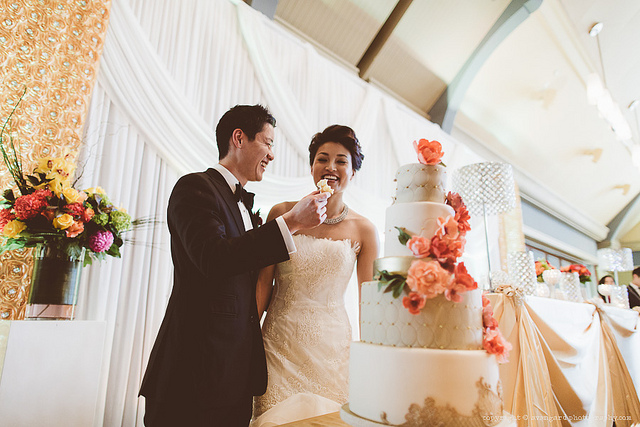Weddings. As we’ve been discussing for most of the month, in the current era they are intractably married (pun intended) to consumerism. But much of that consumerism is marketed as simply being an important part of wedding tradition. There was certainly a point at which wedding tradition turned to consumer opportunity, but don’t mistake the consumer messaging for the heart of the actual wedding tradition. Today, we’re taking a look at the often stark differences between a wedding tradition and what the consumer media machine wants you to believe is the manifestation of that tradition.
The Big White (or Red) Dress
Whether your dream wedding gown is an elaborate white ball gown or a sleeker red gown, it does come from a tradition. We’re going to focus today on the white gown tradition however since it’s the more amusing when it turns to a consumer message. The common misconception about a white wedding dress is that it’s related to the purity and virginity of the bride. Let’s take the snicker about that out of the mix and let you know that in western culture the tradition was actually never originally for a bride to wear a white dress. A bride was supposed to wear a dress that represented the wealth of her family, and most brides wore a dress that they already owned in rich colors. It wasn’t until Queen Victoria married Prince Albert in 1840 and stunned in a white dress that the trend started. And since in contemporary society brides don’t marry as a financial move for their families, there’s no need for the dress to actually be a social representation. Not to worry though! You can still honor the actual historical truth of wedding dresses by wearing a dress that you already own or that can be used again.
The Engagement Rings
These days, men are encouraged to spend upwards of three months of their annual salary on an engagement ring, preferably with a big diamond in it. But the truth of the matter is that diamond engagement rings weren’t ever a wedding tradition until a specific diamond ring manufacturer got smart about marketing. If you want to actually trace back the entire history, you can start with prehistoric man who evidence shows would tie braided grass around his mate’s wrists, ankles and waist to bring her spirit under his control. Are you loving this, women? But the first diamond engagement ring wasn’t seen until the year 1477 when Austrian Archduke Maximillian proposes to Mary Burgundy with an elaborate diamond ring. Of course, diamonds were few and far between and available primarily only to royalty so the “trend” didn’t catch on. It was when the DeBeers diamond company (yes, the one notorious for its lack of a social conscience) launched a diamond engagement ring marketing campaign labeled “A Diamond is Forever” in 1947 that the diamond became the standard. And we likely don’t need to reeducate you on the social issues and price markup associated with buying a five figure diamond ring. Just know that if by “tradition” you mean response to a marketing campaign that’s less than 80 years old, then you are following tradition!
The Gift Registry: It’s Not Really a Tradition
Women, get ready to think twice about what the acceptance of wedding gifts says about how far women have come in the world, because the reality is that wedding gifts are just an evolution of the tradition of a “bride price.” The bride price (also later called the dowry but in reverse) was what was paid to the bride’s family in order to secure the woman (or in many cases girl) for marriage. It was paid by the groom’s family and typically included land and animals (a practice, by the way, that still exists in many cultures). Throughout the years, this tradition obviously changed (though with any massive recession we might not be surprised to see it emerge again in the United States)! In the Renaissance the idea of a hope chest developed to add to the bride’s bounty in the form of everything she’d need to run a home such as linens and dishes. This became the heart of the style of today’s typical wedding gift list. Of course, it truly took the consumer machine to take bridal and wedding gifts to the next level. The wedding gift craze as we know it, however, really began in 1928. That’s the year that retail giant Macy’s had the brilliant marketing idea of introducing the wedding gift registry. So that “tradition” of picking out a china pattern? The real tradition is that once a man would have paid to marry you with two cows and a goat.
Could we list more elements of wedding day consumerism that get marketed as part of “tradition?” Of course! But we think that you get the idea. And we don’t think that you need to strip anything from your wedding wish list just because it’s become shrouded in addictive consumerism. We just ask you to be thoughtful and make your own decisions about traditions that matter versus what you’re being told (or even programmed) to buy.
Did we miss a wedding tradition that’s really a consumer marketing ploy that you want to share with us? If so, just tell us about it on one of the social media channels below.
Facebook | Twitter | Instagram | Tumblr | Pinterest | Google+




